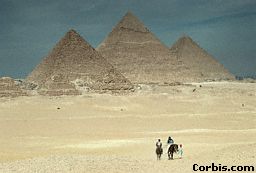EGYPT AND IT'S HISTORY
EGYPT, a republic since June 18th, 1953. It is located in the northeast of Africa and including the Sinai Peninsula in Asia. It is bordered north and east by the Meditarranian sea and the Red Sea respectively. Land boundaries include Isreal to the northeast, Angelo-Egyptian Sudan on the south, and Libya on the west.
The Egyptian flag is a green field bearing a white cresent with horns sinister enclosing three five-pointed stars on a green background.

The land, for all of you geology buffs like me, rests on a granite and diorite substratum overlaid by sandstone and limestone. The latter sedimantary foundations slope slightly from the east and from the west tward the Nile river and south to the north.
Topgraphically Egypt is divided into three parts:
First to the east of the Nile is the Arabian Desert, the mountainous Red Sea coast edge of which contains peaks rising as high as 6,000 feet and exhibits traces of former volcanic activity. Between these mountains and the Nile Valley lies the lower area of the Arabian Desert, which is deeply scored from east to west by wadis, which in ancient times provided important routes of communication between the Nile and Red sea.
Second, to the west of the Nile lies the Libyan Desert, characterized by aeolian formations in the form of sand dunes. It is cut from the north to south by a depression in which seepage from the Nile forms the oases of Kha^rga, Dakhla, and Siwa.
Last is the valley of the Nile. The valley of the Nile is the work of a river which is formed by the union of the White Nile, rising in Uganda, and the Blue Nile, which rises in Ethiopia and joins the White Nile a short distance below Khartoum in the Anglo-Egyptian Sudan. Orgiginally at an age remote in geologic time, of course the Nile was farther west in what is now the Libyan Desert. The reason for the shift of it's bed to the present location is unkown.

For the Archaeological part of Egypt I will go on from here to explain a brief explaination of why I am cutting so much out. I love Egyptology, the history, Geology, and Egypts culture. I love the geology part too, but for locical reasons I must not take up too much space on this since there is so much more I want to add to this section so bear with me.
Herodotus traveled in Egypt about 450 b.c.; the account of the culture and ancient traditions of this land constitutes the second book for it's history. Numerous Greek and Roman writers followed him, and during the time of the Roman Empire, Egypt was a favorite goal of travelers, even as it is today. Obelisks were taken away to the capitols of Rome and Constantinople as in the case of the Occcidental capitols of modern times. Philosophers and craftsmen of Greece sought Egyptian wisdom; men of the Roman Empire espoused Egyptian religion in the cults of Isis and Serapis. The decline of the empire and the rise of the Islam severed the link between Egypt and Europe, and it was not until the Renaissance that Egypt was discovered anew. In 1505 the Hieroglyphia of Horapollon (Horapollo) was published, a late product of the Ancient culture, which gave a fantastic interpretation of the Egyptian script. In the 17th century, Athanasius Kircher elaborated this arbitrary explanation still further and Johann M. Wansleben produced the first of a number of great travel accounts concerning Egypt. Artists of the 18th century employed Egyptian motifs as well as Chinese, and there was a revival of interest in old Egyptian lore, such as Isis and Osiris.
Systematic study of Egyptian Archeaology was inaugurated by Napoleon Bonaparte, who took along with im on his Egyptian campaign of 1798 a staff of scholars and draughtsmen. The results were published in the monumental Description de l'Egypte (1809-1828), of which Egptain antiquities formed the first part. With the finding of the Rossetta Stone in 1799, a starting point was provided for the decipherment of hyrogliphs.
There are several other peices of information that were found by the french as well as other civilizations about the Archaeology of Egypt.
This is all I will have on this for now. I will have an Egyptian Hyrogliphics and Art page up soon. Thank you for visiting.